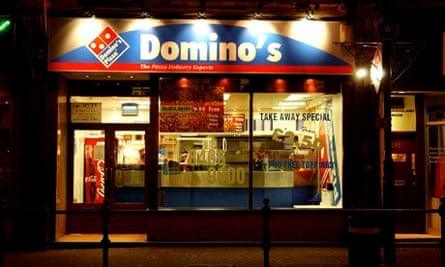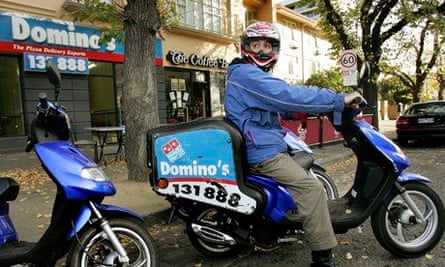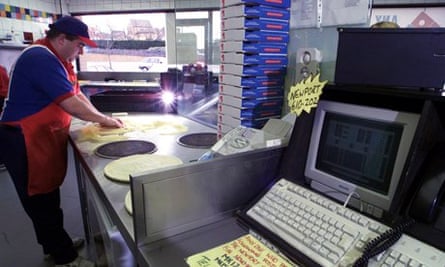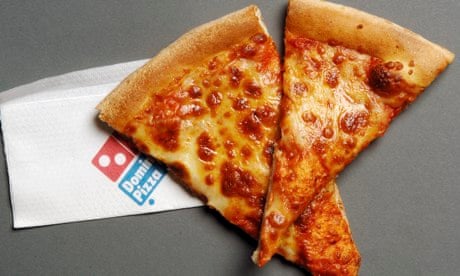Ever-longer working hours, shrinking real incomes and the rise of the internet have made couch potatoes of many of us after a day's work – and that has been very good news for the pizza delivery business.
Britain's biggest pizza delivery chain, Domino's – which has recently been opening nine new outlets a month and now has 777 shops – announced "exceptionally strong" UK sales on Wednesday for the three months to the end of December. Total sales were up nearly 16% to just over £170m, and, excluding new branches sales, rose 11%.
The appeal of an American Hot Double Decadence pizza turning up at the front door after a quick phone call, or a few clicks on a mobile phone, seems unstoppable. Even in the depths of the 2009 recession Domino's boomed as cash-strapped consumers swapped restaurant meals for an evening in.
Britain's Domino's habit started in 1985 with a single branch in Luton, Bedfordshire. A decade later there were 100 stores and in 1999 the company became the first home-delivery business to float on the London stock exchange's Aim market.

Sales soared as the company tapped into greater demand for convenience and the popularity of simply staying in and watching telly. Sponsoring Saturday night TV shows such as Britain's Got Talent and Splash! only increased the temptation for customers.
Such is the chain's ubiquity in the UK, it is easy to forget that Domino's is American. In 1960 Tom and James Monaghan opened their DomiNick's pizza delivery store in Ypsilanti, Michigan.
A year later, Tom exchanged his Volkswagen Beetle for his brother's share of the business and set himself the goal of expanding to three stores. The rest is fast-food history.
Monaghan expanded around the world using the franchising model. Domino's in the UK pays 2.7% of sales to Domino's US to use the brand.

Individual store owners pay the UK company at least £280,000 for a licence upfront, plus a share of sales, and buy their ingredients from the company, prepared at three giant "commissaries" at Milton Keynes, Penrith in Cumbria and Naas in Ireland.
Domino's has 26% of the UK pizza market, just ahead of the longer established Pizza Hut at 25% but with much greater dominance of the growing delivery market.
Wayne Brown, an analyst at City brokers Canaccord Genuity, said Domino's dominance is down to "first-mover advantage" – it launched and rode the home-delivery wave earlier than anyone else.
But it has also kept up with its customers, going online as far back as 1999, embracing social media and launching a smartphone app in 2010.

"It plays to how the customer is behaving. They are using devices for a whole range of reasons and Domino's is benefiting from that, as well as impulse purchasing and British people being time-poor."
Domino's has also kept its delivery times quick, with a target of 30 minutes or less. But is it any good?
With obesity levels rising in the UK, critics will point to the calories lurking in Domino's corrugated cardboard delivery boxes. A large cheese and tomato Dominator pizza contains 2,650 calories – more than a man's daily requirement.
Peter Backman, head of food service consultants Horizons, said: "I think it's all right. It's better than most of the competition and it's better than some of the stuff you can get in the supermarket. Even I order from Domino's, though not too often."

Comments (…)
Sign in or create your Guardian account to join the discussion